#apis cerana japonica
Text
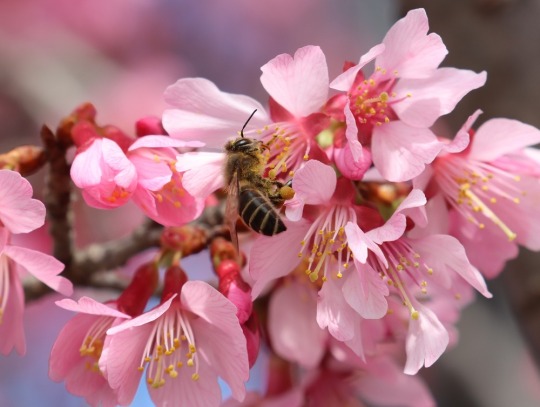
オカメザクラでニホンミツバチが吸蜜+花粉集め。オレンジ色の舌が見えますね(2月29日)
pszczoła(Apis cerana japonica) na kwiatach wiśni (Prunus incamp cv. Okame)
Japanese honey bee (Apis cerana japonica) on cherry blossoms (Prunus incamp cv. Okame)
#Apis cerana japonica#Japanese honey bee#pszczoła#Prunus incamp cv. Okame#cherry blossoms#kwiaty wiśni#flowers#kwiaty#japan#bee#insects#owady#honey bee
22 notes
·
View notes
Text
Yellow-Legged Hornet, Killer of Honeybees, Found in Georgia
The Georgia Department of Agriculture announced earlier this week that a beekeeper in Savannah found an unusual insect later identified by University of Georgia officials as a yellow-legged hornet.
What Did the Actors Bring to Their Back to the Future: The Musical Performances?
Yellow-legged hornets (Vespa velutina) are an invasive species that decimate honeybee colonies, which are…
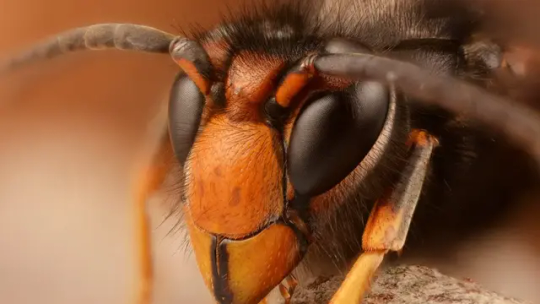
View On WordPress
#Apis cerana japonica#Asian giant hornet#Asian hornet#Bee#Environment#European hornet#Gizmodo#Honey bee#Hornet#Tyler Harper#u.s. department of agriculture#Vespa soror#Vespidae
0 notes
Text


https://susi-kissa.tumblr.com/post/723318222422736896/
ニホンミツバチがスズメバチに襲われた(´・ω・`)
Honey bee[Apis cerana japonica] attacked by wasp
0 notes
Photo

Honey bee (Apis cerana japonica)
毎年恒例の分蜂の季節
今年はお向かいさんの庭に集結
古巣から巣立った女王と、腹一杯に蜜を蓄えた働きバチ達
行先が決まりつつあるのか中央では
距離と方角を伝える八の字ダンスがしきりと行われ中。
それにしてもこんなに小さい分蜂群は初めて、、、頑張ってほしい。
141 notes
·
View notes
Photo

Ant carrying a dead honeybee.
#ant#honeybee#bee#insect#nature#bug#death#Apis cerana#Apis#Apidae#Formica japonica#Formica#Formicidae
2 notes
·
View notes
Note
'lender' The bee would remover her Oni mask only to reveal there was ANOTHER MASK underneath, At least the shadow could borrow this mask for now.
@beesquad | Borrowing from the Shade
“Thanks!”
Oz needed a mask for the upcoming masquerade party, but hadn’t had the time to make one or buy one from Val, and so placed their bets on the Bee being kind enough the lend hers. Oz stared at the mask, holding it in their hands as they turned it over to study it. Before realising that Xioa was still wearing a mask. Underneath the one she just gave them…
“Were- were you wearing a mask over a mask?… how many do you have on?”
#apiphobia | cheerleading squad#Apis cerana japonica | Xioa-Ming#monster prom rp#(( edits: formatted it
5 notes
·
View notes
Photo

By a show of hands, who stopped by just because of the title? Blame nature for the clickbait, not me.
Transcript under the cut.
Hot Bee Balls
Asian giant hornets (Vespa mandarinia) are frequent predators of honey bees, with a few dozen hornets capable of exterminating a colony of 30,000 bees in hours. The hornet’s large size (1.8 in, or 4.6 cm) and thick exoskeleton make it impervious to stings and other attacks, so Japanese honey bees (Apis cerana japonica) have developed a novel defensive strategy: heated bee balls.
The hornets hunt in swarms in summer and autumn. When a hornet scout selects a bee colony for predation, it marks it with a pheromone. A. c. japonica has learned to detect this chemical and quickly swarms the scout, surrounding it from all sides in layers upon layers of bees—sometimes 500 at a time. The bees then quiver their wing muscles, generating body heat and increasing the CO2 concentration inside the ball. The centers can reach 115 °F (46 °C), killing the hornet within 30 minutes.
Though it wouldn’t be surprising for the bee-ballers to die too—honey bees are famously willing to sting and die for the colony—about three quarters survive. However, it does appear to shorten their lifespan compared to bees that didn’t participate. Bees that participate once are more likely to join future attacks, sacrificing their own longevity to keep the rest of the hive at peak productivity.
#scientific illustration#entomology#bee#honey bee#biology#animal behavior#science fact friday#my art#artists on tumblr#original art#I'm back! properly back#have I moved back into my room yet? no next question#is this line spacing more legible? I feel like it is
423 notes
·
View notes
Note
Hi again! So, you've probably heard about it by now, but I saw an article about the possibility of Asian giant hornets having migrated over to the U.S. I clearly have no knowledge on the subject beyond what I read in the article (and that's hardly any basis to form an opinion on lol) and I know that this kind of falls under your realm of expertise, so I was wondering if you might have anymore information to offer and possibly alleviate some anxieties??
Hi there! Yes, it seems it’s been bombarding everyone’s news feeds the past few days. I was actually just asked to talk about it on the radio today. I’ll preface this with the fact that I am not super familiar with the biology of this particular species, though I had heard of it before all of this and it’s heckin cool.
Is this wasp a problem? Potentially, yes. Should we call it a ‘murder hornet’ and use it as fodder for wasp hate everywhere? Absolutely not. If the Asian Giant Hornet is a problem, it’s because it could be invasive, not because it’s a wasp. Let’s break that down.
In its home range, this massive wasp specializes on hunting honeybees. Honeybees in Japan are not our honeybees, they’re an entirely different species, Apis cerana japonica (as opposed to western honeybees, Apis mellifera). Japanese honeybees evolved alongside this species, and they are together part of an ecosystem - giant hornets like this don’t just pop up like Godzilla ready to demolish society, they look and act the way they do because of millions of years of evolution alongside predators and prey and their environment. Their arms race is with the Japanese honeybee, which can tolerate temperatures in excess of 115 degrees Fahrenheit, and they will swarm the infiltrating wasp and cook it alive. This is a unique, special adaptation that came about because these two have been duking it out forever. So that’s step 1. This wasp is not some monstrous thing born of Cthulhu. It has an ecological place. Honeybees over there are perfectly used to it, just another day for them (there’s actually two other giant hornet species that attack hives sporadically as well over there). We just think it looks terrifying because it’s different than what we’re used to, and it amplifies our already-present fears of wasp-shaped creatures.
Step 2.1 The reasons why it could pose a problem in the U.S. Firstly, its sting is dangerous; obviously, its sting is very large and can deliver a lot of venom, and if you’ve seen the Coyote Peterson video on it, it causes long-lasting swelling and pain. One or even a few stings will not severely harm you, but seven, eight, a dozen, could potentially send you to the E.R. with severe inflammation and even renal failure. You’re more at risk from complications from fewer stings if you have pre-existing inflammation or breathing problems, and if you get stung someplace like your neck or face. Most victims, even those who are hospitalized, do make a full recovery. That being said, like any other social wasp we have, you’re only likely to get stung if you accidentally stumble upon a nest and can’t book it out of there fast enough. I cannot vouch for the natural aggressiveness of this species, but given its size, life history, and similarities to related species, I would say that it will probably have a fairly proactive response to disturbance, aka, yes, it absolutely does pose a health risk to humans and this is a valid reason to be concerned.
Step 2.2 The other reason people are worried. This wasp targets honeybees, which most people know are extremely important for our agricultural system. It can decimate whole hives of western honeybees, as they have not evolved the defenses necessary to fend them off. However, I’ve heard things like ‘they’re going to contribute to bee declines!’ and that is simply not the case. Honeybees are not native - they are not an essential part of our ecosystem, only our agricultural one. It will be an economic loss if we start losing honeybee colonies, but honeybees are not the bees that we should be concerned about here in North America. It’s our native bees that are declining at startling rates. These hornets will not attack our native bees, because they don’t build hives! Only a very small percentage of our >3,500 species of native bee live in colonies, and they’re almost all underground and with a tiny fraction of the number of workers that a honeybee colony has (instead of tens of thousands, think, a couple dozen). The rest are totally solitary. Not what this wasp is looking for; it has a search image, it knows how to seek out honeybee colonies and I highly doubt it would recognize bumblebees or sweat bees as prey. The reason why this hornet has the potential to do so much damage in the first place is a classic problem with monocultures; grow (or in this case, raise) too much of one thing in one place, and when a disease or pest comes by, it can easily sweep through the population with high mortality. It’s been recognized for a while now that we rely far too heavily on honeybees for our pollination; concerns over Colony Collapse Disorder sparked these discussions. This whole time, we should have been providing for wild, native bees, by giving them the habitat they need to live alongside us and pollinate our crops. Instead, we’ve pushed them out with monocultures, pesticides, and development, then decided to bring in a non-native species to replace them. This is a setup for disaster. The presence of this new threat should be a wakeup call to change our ways.
Step 3. Do not judge all wasps by this one species. ‘Murder hornet’ is not a term that allows us to discuss this animal objectively. The VAST majority of native wasps are small, stingless species which most of us never notice, yet they perform invaluable ecological services as parasitoids. Our stinging species are still mostly solitary and non-aggressive, and are pollinators and predators on common garden pests. And you know what? Yellowjackets, bald-faced hornets (not a true hornet, actually), paper wasps, the ones people don’t like? They’re beneficial too, for the same reasons as above. They are a crucial part of our ecosystem, and are aggressive only if we threaten their colonies, which contain their young. This introduced species posing risks to us does NOT give us the right to condemn our native species to fear and hatred. Wasps already have a bad rap. Don’t make this fuel for the fire. If this wasp is dangerous, it’s not because it’s a wasp. It’s because it’s an invasive species that lacks the checks and balances of its natural habitat. Invasive species can be plants, fungi, or animals, and just because this one is a wasp doesn’t mean you get to lump all other wasps in with it.
Lastly, I’m already seeing people all over the country start to claim they are seeing this wasp. You are not. Unless you live in Washington, at this time, you’re seeing something else. Let me show you a few, in case you are mistaken:
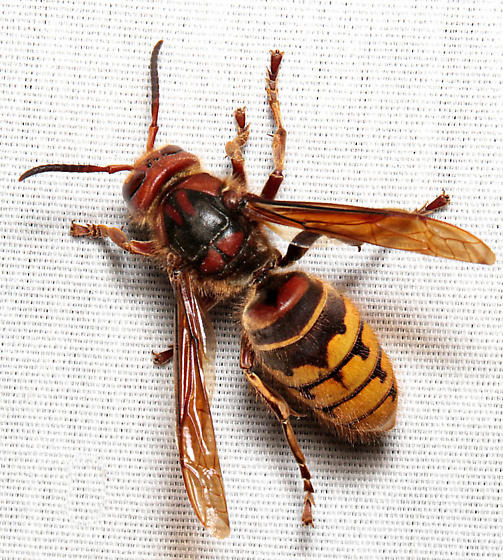
European Hornet - Vespa crabro. (Photo) Non-native, but established in the eastern U.S. Largest wasp most people have ever seen, but still half the size of the queen Asian giant hornet. Acts like other yellowjackets and such, no serious ecological threat.
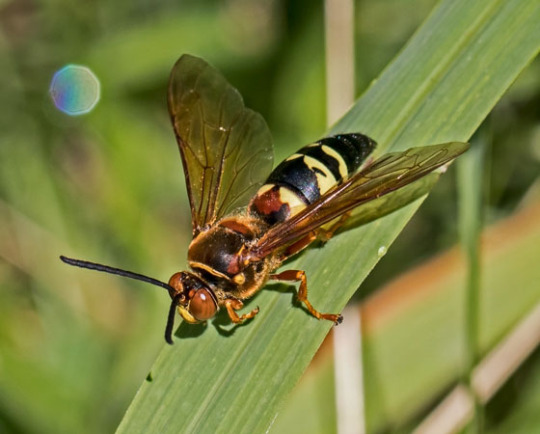
Eastern Cicada Killer - Sphecius speciosus (photo). Native, found east of the Rockies. Specializes on hunting cicadas. A large, solitary wasp, but not aggressive. Lives in burrows in the ground. About the size of the European hornet. They like sandy areas, so you might see them in fields or playgrounds.
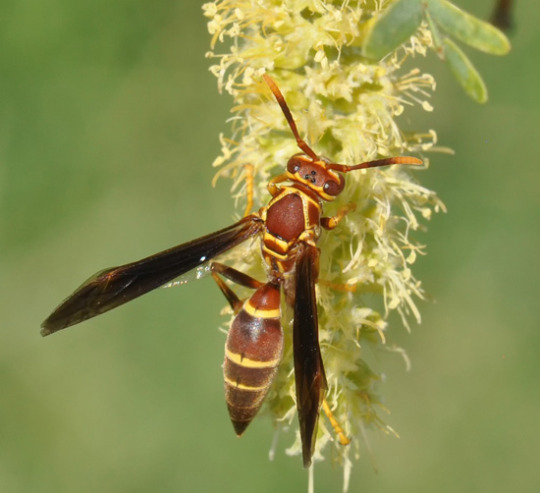
Paper wasps - Polistes spp. (photo). Native, common across the country, some species have yellow markings, others are brown or reddish. Social wasps, they build paper nests under awnings near human habitation, can be somewhat aggressive if you get too close to the nest but otherwise are approachable when foraging on flowers. Smaller, usually 3/4 inch or so.
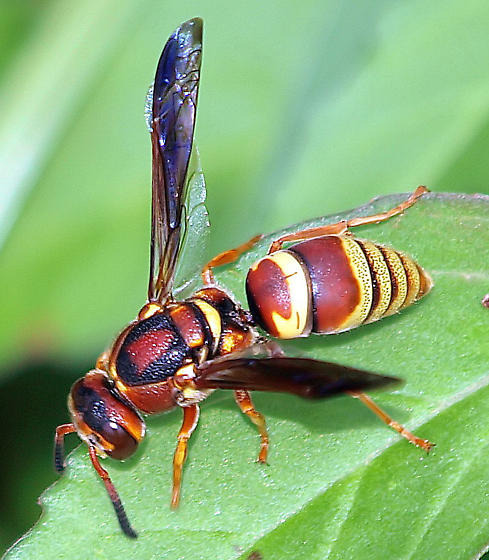
Potter and mason wasps - Eumeninae spp. (photo). We have hundreds of species of potter wasp, and in the southern U.S. many of them have red and yellow markings. This particular one is Euodynerus pratensis from Texas. These are solitary wasps, and are not very large, usually not exceeding 1/2 an inch, maybe the largest are 3/4in. They make mud nests, sometimes near human habitation, but they are docile and rarely cause conflict.
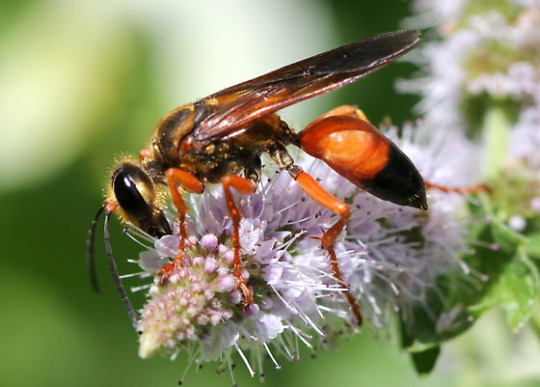
Great Golden Digger Wasp - Sphex ichneumoneus (photo). Common across the U.S., a large native solitary wasp common on flowers. Not really the same body structure as a vespid but just in case... these guys scare some people because they are large and gangly but they hunt grasshoppers and katydids and are generally non-intrusive. They live in underground burrows, not near humans. They’re good pollinators too!
I hope that alleviates some fear that comes with people starting to claim they’re seeing this wasp where it isn’t. It’s just another case of boy cries brown recluse spider. Most people are so unfamiliar with our native insect fauna that once they start noticing wasps, everything looks like the culprit just because they weren’t paying attention to what’s always been around them.
It sounds like they don’t know the extent of establishment yet, or when/how the AGH was introduced. Chances are, if people are starting to find them, then it’s already got a population. However, if early response methods can effectively control their spread, there’s a chance we can eliminate them. We have hundreds of invasive species here in the U.S. that are wreaking havoc on our ecosystems because we missed the short window in which to eradicate them. We do not know the total impact this hornet could have, until we thoroughly read the literature on its ecology back in Asia. It does pose a significant economic risk though, and a human health risk if they end up dwelling near human habitation (which they shouldn’t, I would think, unless you’ve got honeybee hives or feral colonies around). What we’re seeing is two non-natives battling it out - two species that should not be in North America at all. I do hope that we are able to stop this invasion in its tracks, but I also really hope it makes us reconsider the flaws in our agricultural system.
#thehermitreversed#asian giant hornet#wasps#insects#mine#i hope this helps a little?#i cannot deny that getting stung by this bamf can be deadly under certain circumstances#anyone else in this field who knows more about this situation please feel free to chime in!
11 notes
·
View notes
Photo

Japanese honey bee (Apis cerana japonica)
Some prefer their honey, but I’ve never tried yet, cause a bit expensive
23 notes
·
View notes
Photo
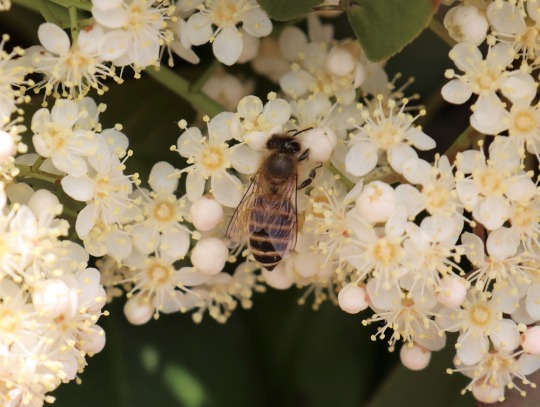
カナメモチ(アカメモチ)で吸蜜するニホンミツバチ(4月18日)
#Apis cerana#eastern honey bee#Asiatic honey bee#Asian honey bee#Apis cerana japonica#bee#pszczoła#pszczoła wschodnia#Photinia glabra#Japanese photinia#flowers#kwiaty#owady#insects#japan
31 notes
·
View notes
Photo

Cerasus lannesiana 'Kawazu-zakura' #河津桜 #sakura #サクラ #カワヅザクラ Apis cerana japonica #Apis_cerana #honeybee #bee #トウヨウミツバチ #ニホンミツバチ (ローソン 吉岡陣場店) https://www.instagram.com/p/Buz9yryAmvM/?utm_source=ig_tumblr_share&igshid=1r2rjuscclgay
0 notes
Text

日本蜜蜂[Nihonmitsubachi]
Apis cerana japonica
日本[Nihon] : Japan
蜜[Mitsu] : Honey, nectar
蜂[-bachi|Hachi] : Bee, wasp
It is a subspecies of 東洋蜜蜂[Tōyōmitsubachi](Apis cerana.) 東洋[Tōyō] means the East.
In Japan, there is also another type of bee called 西洋蜜蜂[Seiyōmitsubachi](Apis mellifera,) which was introduced during the Meiji period (1868-1912) because their herd is larger and they could collect more honey. 西洋[Seiyō] means the West.
Seiyōmitsubachi differs from Nihonmitsubachi in that it is slightly larger and its abdomen is partially indistinct stripes with orange tinged. And, they have no way to defend themselves when attacked by one of their natural enemies, 雀蜂[Suzumebachi](Japanese giant hornet,) but not Nihonmitsubachi.
https://www.youtube.com/watch?v=GbMLzSMJ12U
茶の木[Chanoki]
Camellia sinensis
茶[Cha] : Tea
の[No] : Of
木[Ki] : Tree
Its origin seems to be around southwestern China. It is estimated to have been introduced from China in the early Heian period(794-1185.) The custom of drinking tea and the tea ceremony became widespread after the Kamakura period(1185-1333.) The great majority of green tea consumed in our country today is the やぶきた[Yabukita] cultivar.
https://en.wikipedia.org/wiki/Eisai
https://japan-food.jetro.go.jp/greentea/
15 notes
·
View notes
Video
instagram
Бджілки гріють в обіймах гігантського шершня-вбивцю. Навіщо вони це роблять? Гігантські японські шершні (Vespa mandarinia japonica) є страшними ворогами бджіл. Всього кілька таких можуть знищити населення цілого вулика. У прямому зіткненні бджоли не здатні перемогти шершня, але японський вид бджілок apis cerana japonica виробив дієвий засіб боротьби з загарбниками. Передовий загін бджіл обліплює ворожого чужинця і, виділяючи тепло, доводять температуру до смертельного для шершня рівня. Самі ж бджілки до нагріву більш стійкі. Вбити ворога також допомагає високий рівень вуглецю в центрі бджолиного скупчення. Отже, не завжди перемагає той, хто сильніший. Думай-те.😏🐝 #цікавинки (at Україна Ukraine) https://www.instagram.com/p/CDy9IlIBuHR/?igshid=yeiff9sh1pzr
0 notes
Text
Are Japanese ‘murder hornets’ invading North America?
Register at https://mignation.com . The Only Social Network for Migrants. ---
New Post has been published on http://khalilhumam.com/are-japanese-murder-hornets-invading-north-america/
Are Japanese ‘murder hornets’ invading North America?
It's unlikely they will murder you, but they pose a serious threat to honey bees
Japanese giant hornet attacking a hive. Photo courtesy Stephen Wheeler.
In early May, the New York Times reported that the United States faced yet another new threat besides the COVID-19 pandemic: “murder hornets” from Asia. The story quickly sparked an explosion of “murder wasp” stories and social media conversations around the world. As a viral idiotic stunt on YouTube from 2018 resurfaced and surged in popularity, some reporters reassured readers that “‘murder hornets’ are unlikely to murder you personally,” while others asked just what exactly is a “murder hornet”, anyway? According to the Times report, the Asian giant hornet (Vespa mandarinia) is now present not only in the northwest corner of Washington State, but also just over the U.S.-Canada border to the north, in White Rock, a suburb of Vancouver. In September 2019, an Asian giant hornet nest was discovered and destroyed on nearby Vancouver Island as well.
A dead Japanese giant hornet, or O-suzumebachi (オオスズメバチ) in Japan. Photo by Nevin Thompson.
It's a mystery how the Asian giant hornet arrived in western North America. The hornets can be found in Taiwan, China, South Korea and in Japan, where the insect is known as o-suzumebachi (オオスズメバチ), which roughly translates as “great sparrow wasp”. The hornets are about 5 cm in length, and defend themselves from predators such as bears by biting and spitting venom, and with a powerful sting. In Japan, the giant hornets prey on honey bees, which means they pose a significant threat to apiaries in Washington State, British Columbia and other parts of North America.
Why are they called ‘murder hornets'?
The New York Times story almost immediately sparked confusion. Some took issue with the claim that the hornets “kill up to 50 people a year” in Japan (the figure is actually 12 deaths a year, according to Japan's Ministry of Health, pointed out by a commenter on Twitter). Entomologists in Canada, which has been investigating the presence of the hornet for at least a year, also downplayed the potential threat to humans.
Did a murder hornet write this https://t.co/SP9zRSZoRG — Jimmy Thomson (@jwsthomson) May 4, 2020
However, for many Japan-watchers, the most confusing part of the Times story was just where the name “murder hornets” came from. Martin Fackler, the former Tokyo bureau chief of the New York Times, noted that, in Japan, hornets are called suzumebachi — a “bee” (hachi) or hornet the size of sparrow (suzume). Fackler and New Yorker contributor Matt Alt deduced the term “murder hornet” turned up in the New York Times as the result of a sort of “reverse telephone game”:
Yeah, I did a quick search in Japanese for variants of satsujinbachi (殺人蜂), which seems to be the origin of “murder hornet,” and the term was probably originally a direct translation of the English “killer bee,” though Japanese tabloids now use it for Asian giant hornets, too. https://t.co/mlE8KpKNmu — Martin Fackler (@martfack) May 4, 2020
How Japanese beekeepers fend of giant hornets
“The Japanese giant hornet warns you it will attack by grinding its jaws together,” says Stephen Wheeler, a beekeeper in Japan, in an interview with Global Voices. “Single Asian giant hornets aren’t a problem if you encounter them, though. Freeze, don’t try and swat at it, and back off.” Wheeler fights a battle every year to keep his bees safe from giant hornets. Since 1993, Wheeler has lived on Awaji, a largely rural island to the west of Kobe and Osaka at the eastern end of the Inland Sea. Wheeler has been beekeeping on Awaji for about eight years, and currently rents farmland for growing bee-friendly trees for reforestation “A neighbour gave me two old hives which I placed at a friends coffee shop, and I was lucky enough to catch my first two swarms of honey bees,” says Wheeler. “I keep the Japanese honey bee (Apis cerana japonica) and when swarms escape from strawberry farms, I keep the European honey bee (Apis mellifera) too.” Wheeler documents life on Awaji, including keeping bees, producing honey, fending off wasps and generally investigating insect life on his blog.
“Managing an Asian hornet attack with sticky pads.” Image courtesy Stephen Wheeler.
Unfortunately, over the past winter, Wheeler lost all of his bee colonies, as he explains in a video blog. “It was a downward spiral,” says Wheeler. “Yellow hornets in the summer, giant hornets in the autumn which means the bees can’t leave the hive to forage. Honey and pollen reserves dwindle, the bees can’t keep the hive in tiptop shape, and stress settles in. The hive succumbs to wax moth or a mite problem, they all just evacuate, which in autumn is a death sentence in and of itself.” There will be no bees left, Wheeler says, to survive the winter and continue on with the colony in spring. Wheeler has documented a variety of tactics in his fight against the Asian giant hornet on his YouTube channel. Here, he explains how the hornets release pheromones to summon help, and how to use this behaviour against them: [youtube https://www.youtube.com/watch?v=PCaTQ_8F3vY?feature=oembed&w=650&h=366]
Written by Nevin Thompson · comments (0)
Donate · Share this: twitter facebook reddit
0 notes
Text
@beesquad | Continued from Here
Xioa-Ming would grimace under her Oni mask she’d made her distaste for shadow clear earlier, Though she’d give them the benefit of the doubt for now easing her grip off her sheathed katana.
“One should never strive to ‘fit in’ it’s foolish to want to be like the mindless masses.” Her tone was evidently coming from a place from experience, The slight weak smile on her face basically being projected through the mask. “Be true to yourself, And those who honestly care about you will stick around.”
“If you are feeling burdened with strife perhaps you’d like to meditate with me young grasshopper.”
“What if being true to myself means being a soul-eating horror?” They asked, almost too innocently. Their expression is blank, save for the strange look in their eyes.
“And... meditate? What’s that? I’m afraid I’m unfamiliar with the term.” They gave a half shrug, tilting their head at Xioa-Ming. “If it helps me with being more ‘true’ to myself, which you see as a good thing, I shall try it.”
3 notes
·
View notes
Photo

カナメモチ(アカメモチ)の花にニホンミツバチ(左)とセイヨウミツバチ(右)が来ていた。このツーショットはめったに撮れないのでうれしい(4月18日)
#Apis cerana japonica#Apis mellifera#Photinia glabra#eastern honey bee#Asiatic honey bee#Asian honey bee#Pszczoła wschodnia#western honey bee#European honey bee#Pszczoła miodna#Japanese photini#bee#pszczoła#insects#owady#flowers#kwiaty#japan
6 notes
·
View notes